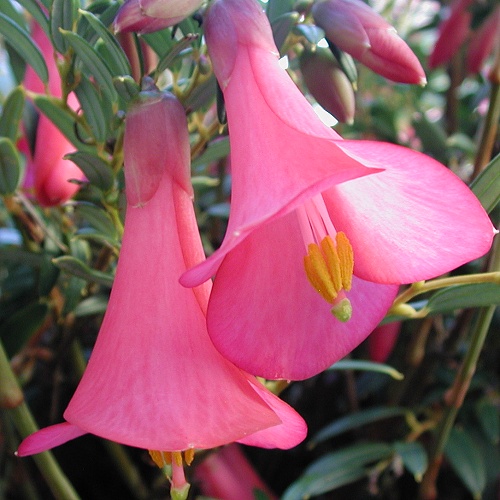Germinating the seeds
Stored seeds don't germinate well, so please deal with them when they arrive.
Getting started -- Your seeds should be given a 6 week cold treatment in the refrigerator for best germination. This tricks them into thinking winter has passed, so they germinate better. Place the seeds in a small, sealed, plastic or glass container, and fill it with a few ounces (100-200mL) water. Place them in a refrigerator that doesn't freeze (inside the door is usually the warmest part). Mark your calendar to change the water once a week, and remove them after 6 weeks. After cold-treatment -- Use pots about 3-4 inches tall (8-10 cm) and 3 inches wide, with drainage holes. Alternative, you may plant them all in a single pot, by spacing them 2 inches (5cm) apart. Use a well-draining soil mix, such as 2 parts potting soil to 1 part perlite or coarse horticultural sand. An alternate mix is equal parts of coir fiber and perlite (use small- or medium-size perlite, not big chunks). You may add some granular fertilizer, but don't add lime to the mix, because they prefer slightly acid soil. Place a seed in each pot, and cover with a thin layer of soil (1/8 inch / 3 mm) of the mix. Add enough water so the soil is evenly moist, but not completely saturated. If your tap water is very high in minerals ("hard water") it's best to use bottled water or rain water. Until the seeds sprout, keep the pots between 60-78 degrees F (15-25°C) during the day, and a bit cooler at night (50 to 74°F / 10-23°C). Avoid letting them get above 82 degrees F (28°C). I recommend placing a minimum/maximum thermometer near the pots, especially if using a heat mat. Give them some air circulation to prevent stem rot later. Don't let the soil surface dry out, but don't keep the soil constantly soggy either. The seeds sprout at different times, usually beginning between 8 and 12 weeks, and continuing for another 2-4 months. Once they sprout, give them bright light, but shade them from strong sun exposure (See: "Growing indoors with LED lights"). Water them enough to keep the soil surface from drying out (but again, avoid keeping them soggy). Avoid transplanting them the first year. Growing onward.. Philesia prefers conditions enjoyed by cool-temperature Orchids. It's happiest in temperatures below 79 degrees F (26 C), with nights below 60°F (16°C), but the first 2 years, keep them between 54-70°F (12-21°C) at night. There are scattered reports of mature plants handling heat fine, but it might not thrive if temperatures consistently rise above the low 80s (28 degrees C), especially if nights are warm. It can tolerate a few degrees of frost, but it's best to protect it from freezing temperatures, especially the first few years. This forest plant likes dappled sunlight or morning sun. Protect it from strong afternoon sun. It often grows as an epiphyte in the wild, so it appreciates an open, quick draining soil mix that's kept evenly moist. Don't let the roots dry out. Over 50% humidity is best, with good air flow. Be gentle whenever repotting to avoid damaging the delicate roots. Avoid transplanting them once they have several shoots, as this may delay flowering. A 3 gallon (12 liter) pot should hold the plant for at least 10 years. Pests to watch for -- Protect from snails & slugs, perhaps by growing it in a hanging basket. Watch for spider mites and scale. If you have any questions, please contact me. Have fun growing them! - Jeff Strange Wonderful Things
|
|||||||||


